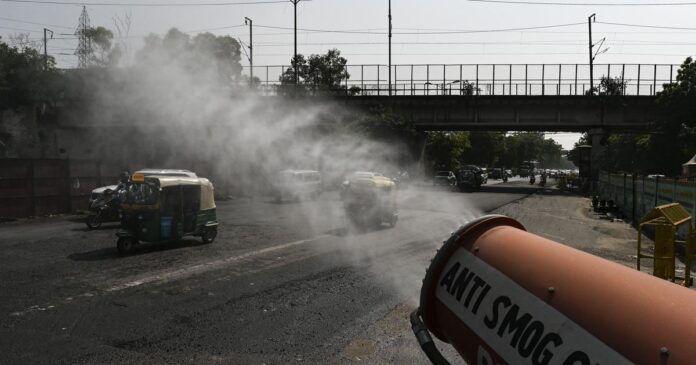For the first time in this season, the Air Quality Index [AQI] of New Delhi has been categorized as ‘very poor’. The Central Pollution Control Board on 16 October, has provided the value of the AQI for Delhi set at 304. The AQI is a comprehensive mechanism for the measure of the air status in understandable terms. The process it follows is that it transforms complex data of air quality of various pollutants into an index value, nomenclature and colour. There are a total of 6 AQI categories- namely, Good, Satisfactory, Moderately polluted, Poor, Very Poor, and Severe.
These categories are decided based on ambient concentration values of air pollutants and their health impacts, known as breakouts. The air quality sub-index and health breakpoints are evolved for right pollutants- PM10, PM2.5, NO2, SO2, CO, O3, NH3, and Pb for which National Ambient Air Quality Standards are prescribed up to 24 hours. An AQI above the level of 300 has been categorised as ‘very poor’ by the Central Pollution Control Board, while the range for categorizing an AQI as ‘poor’ is ranging from 201 to 300.
Air Quality Index at a Global Level:
In comparison to the standards of measuring the quality of air at a global level, the Indian measure of AQI is seen to be considerably high. The Ministry of Ecology and Environment in China, considers an AQI above the level of 300 is categorised as ‘very poor’. Also, in the United States of America (USA), the Environmental Protection Agency (EPA) considers the level of AQI going above 100 as ‘unhealthy’ and an index above 300 as ‘hazardous’. The Central Pollution Control Board [CPCB] has received data of over 108 countries, out of which 10 have been recorded at level above 300. The worst recorded AQI is India has been recorded in Loni, Ghaziabad with the AQI at 358.

As per a monitoring system developed by the Indian Institute of Tropical Meteorology [IITM]- Safar, Chndni Chown in old Delhi recorded PM 2.5 levels of 314. These are particles so fine that it is capable of entering our blood stream and causing various cardiovascular and respiratory diseases. PM 2.5 is of the worst pollutants and no level of its presence can be categorized as safe.
The probability of asthma attacks, bronchitis and other pulmonary diseases increases especially for those with an already suffering lung or heart condition. Therefore detecting levels of PM 2.5 in the air can be extremely dangerous. The hustling area in Old Delhi, also recorded a PM10 level of 258, which can enter and lodge in the lungs of a human body.
Farm Fires and adverse effect on AQI:
Early winters are considered to be the peak season for seeing severe air pollution in most parts of North India. A change in weather patterns, especially when there is lower wind speed and fall in temperature, the polluted air seems to get trapped closer to the ground. The sources of pollutants could be anything from emissions from factories and vehicles, dust, fire farms etc.

After the kharif harvest, one practice seen among the paddy farmers in Punjab, Haryana and some parts of Uttar Pradesh is that they burn subtle and loose straw causing farm fires. This helps the field to prepare itself for rabi crops. Safar’s finding this year has released that the farm fires are going to further contribute to the ongoing level of pollution, further deteriorating the AQI in the capital city, New Delhi. However, what is interesting to note that only 5% of the PM 2.5 levels can be attributed to stubble burning.
Delhi Government responds:
Arvind Kejriwal has remarked that it is not always possible to clearly establish the cause of the air pollution in Delhi and what the different sources of it are. He has assured the people of Delhi that the government has been doing its best though unable to control the issue of stubble burning. Due to the delayed withdrawal of monsoon this year, the occurrences of farm fires have been comparatively low.

Downpours in late September means that the paddy crop still has high levels of moisture and thus the farms are not ready for harvest in early October. There has been the issue of an advisory from the Punjab Agriculture University requesting the farmers to delay their harvest due to rains on September 27 and September 28.
The International Maize Wheat Improvement Centre in New Delhi and Balwinder Singh, who did a study on the phenomena of crop burning in Punjab and Haryana is predicting the air pollution situation to get worse by the end of October,
“Harvesting is getting late this year and burning will move into the cooler days of November, which will be more harmful as particulate matter will not disperse in cooler days. Another risk in delayed harvesting is that many farmers will harvest and burn the residue within a short time span towards the time between the end of October and early November, which will increase the intensity of fire events and also particulate matter,” he said

